Economics & Quantitative Analysis: Regression of Retention Rate
VerifiedAdded on 2023/04/24
|10
|1737
|321
Report
AI Summary
This report investigates the correlation between graduation rates and retention rates in online colleges using simple linear regression. The analysis includes descriptive statistics, a scatter diagram, and a regression equation (y=0.2845x + 25.423). The results indicate a positive relationship, with a slope coefficient of 0.284, suggesting that a higher retention rate positively influences the graduation rate. The R-squared value of 0.45 indicates a moderate fit, explaining 45% of the variance. The report also discusses the implications for university presidents, recommending strategies to improve student retention and engagement. It concludes that while some universities show promising retention rates, others, like the University of Phoenix, need to address low retention issues.
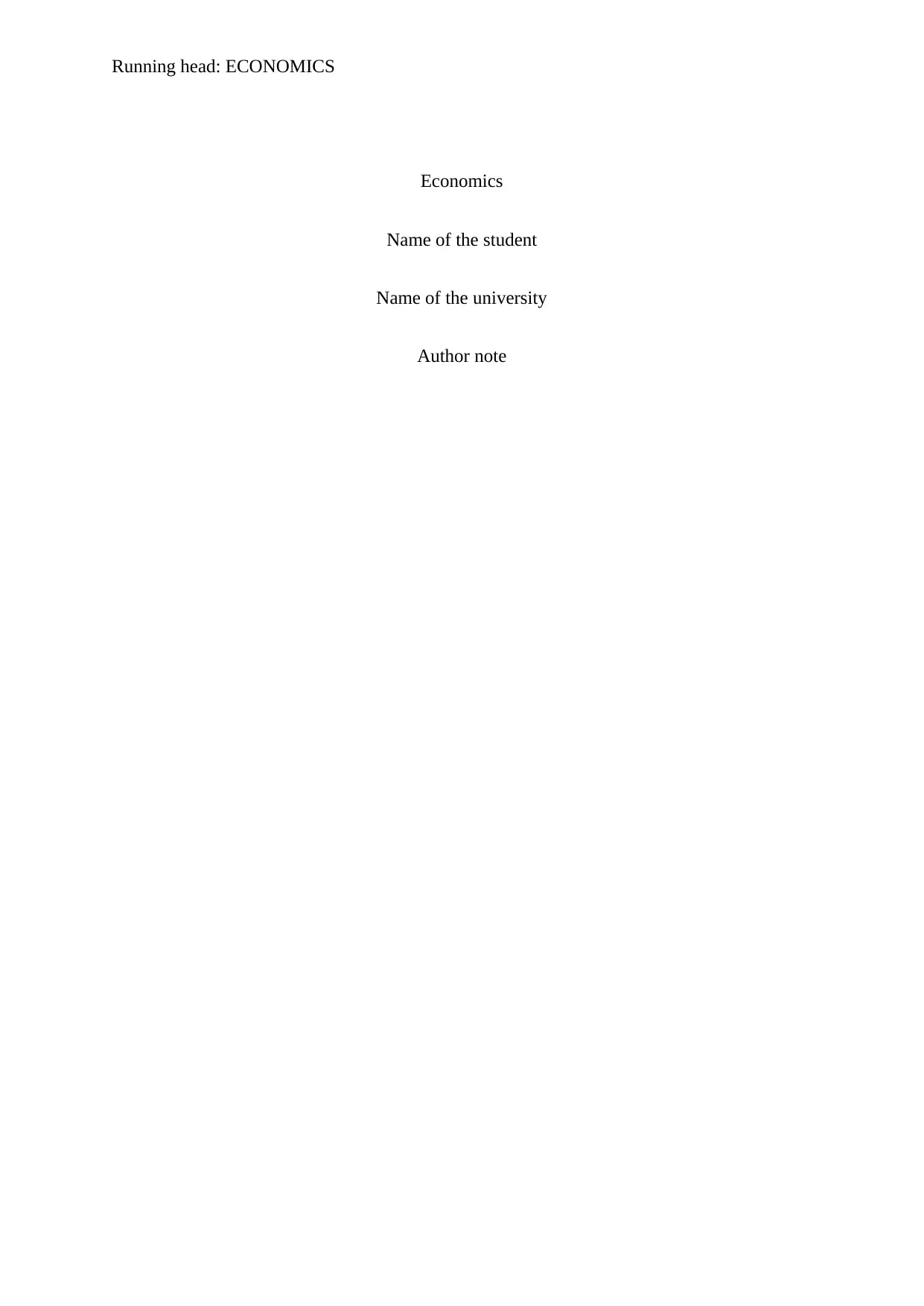
Running head: ECONOMICS
Economics
Name of the student
Name of the university
Author note
Economics
Name of the student
Name of the university
Author note
Paraphrase This Document
Need a fresh take? Get an instant paraphrase of this document with our AI Paraphraser
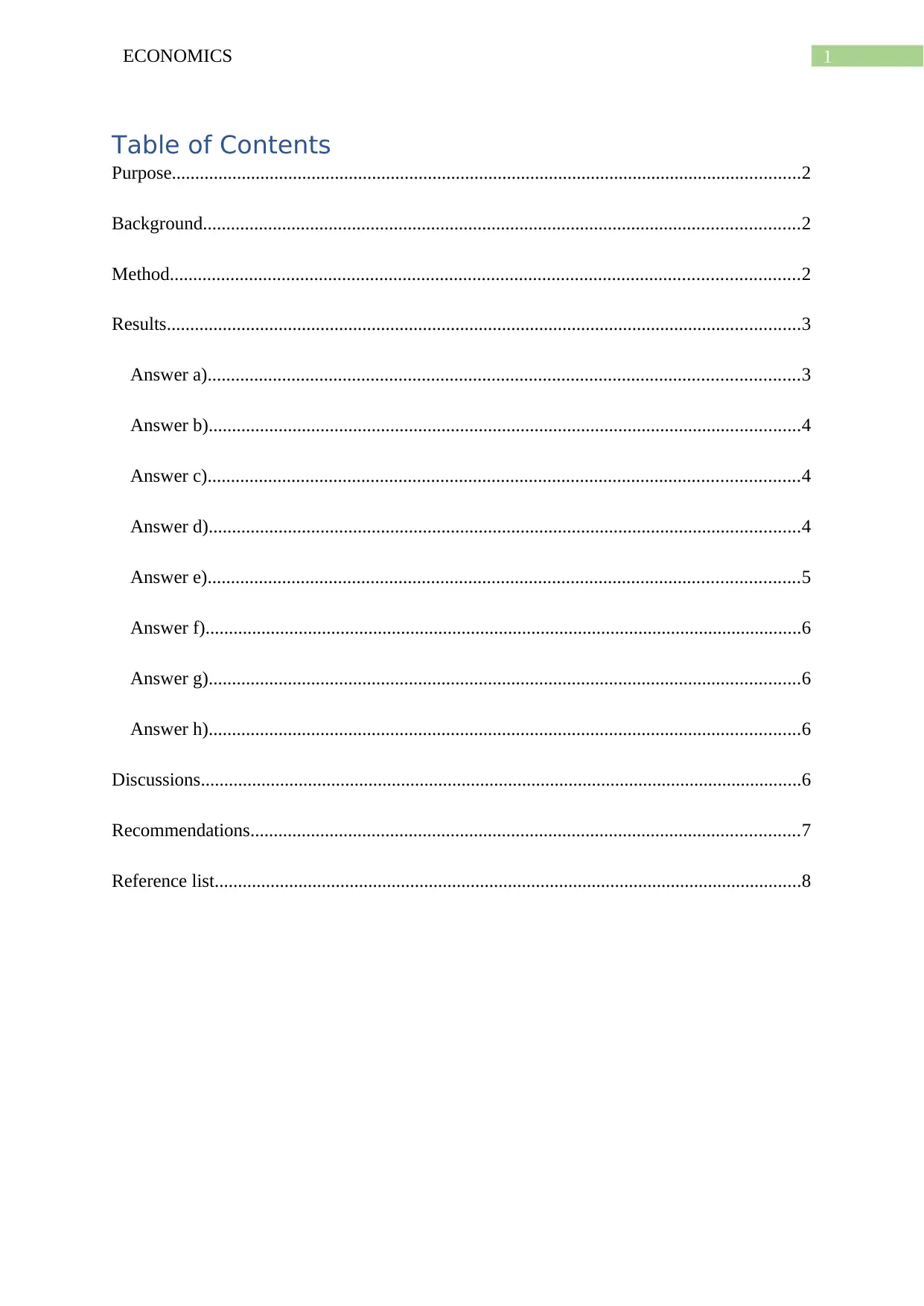
1ECONOMICS
Table of Contents
Purpose.......................................................................................................................................2
Background................................................................................................................................2
Method.......................................................................................................................................2
Results........................................................................................................................................3
Answer a)...............................................................................................................................3
Answer b)...............................................................................................................................4
Answer c)...............................................................................................................................4
Answer d)...............................................................................................................................4
Answer e)...............................................................................................................................5
Answer f)................................................................................................................................6
Answer g)...............................................................................................................................6
Answer h)...............................................................................................................................6
Discussions.................................................................................................................................6
Recommendations......................................................................................................................7
Reference list..............................................................................................................................8
Table of Contents
Purpose.......................................................................................................................................2
Background................................................................................................................................2
Method.......................................................................................................................................2
Results........................................................................................................................................3
Answer a)...............................................................................................................................3
Answer b)...............................................................................................................................4
Answer c)...............................................................................................................................4
Answer d)...............................................................................................................................4
Answer e)...............................................................................................................................5
Answer f)................................................................................................................................6
Answer g)...............................................................................................................................6
Answer h)...............................................................................................................................6
Discussions.................................................................................................................................6
Recommendations......................................................................................................................7
Reference list..............................................................................................................................8
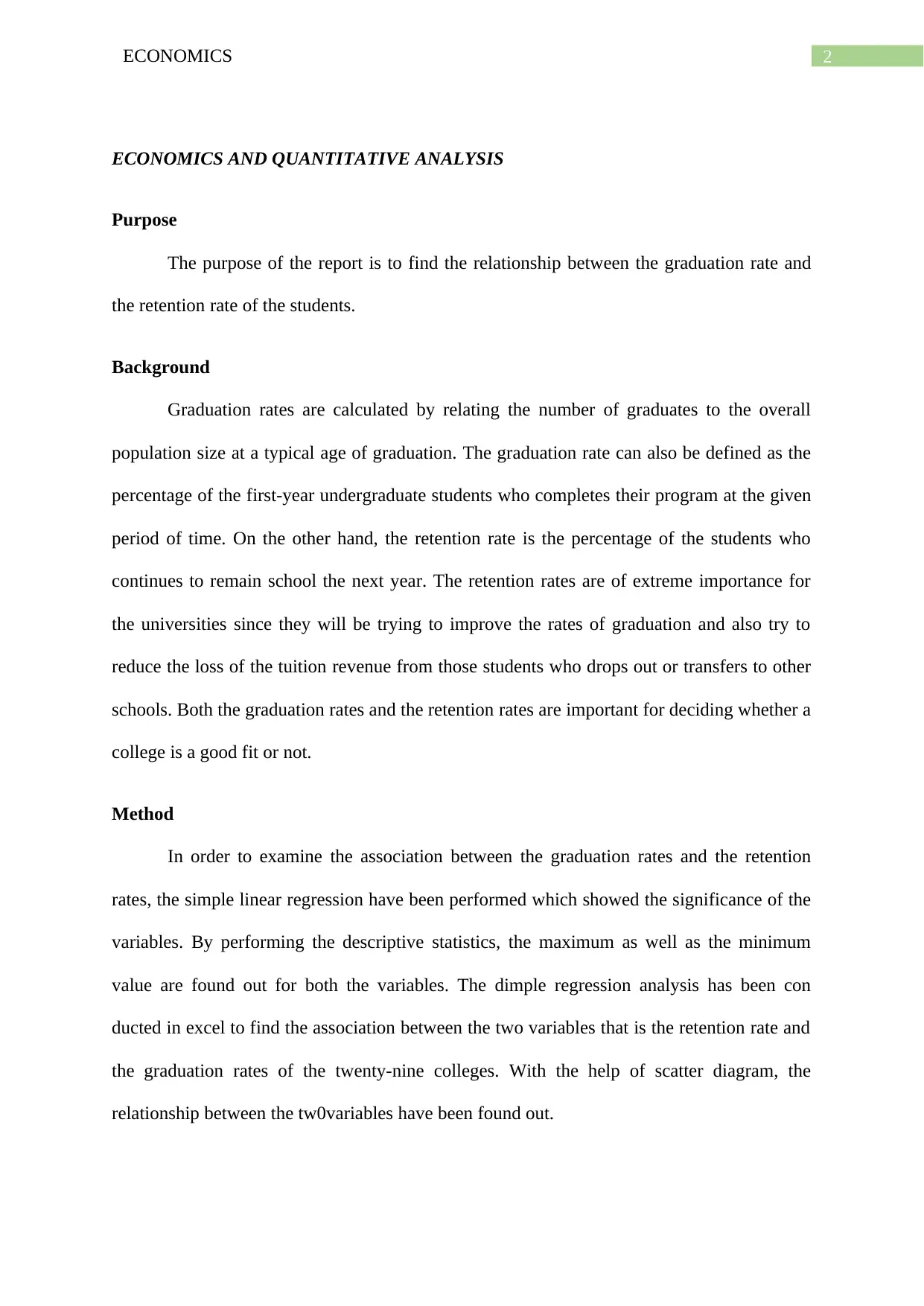
2ECONOMICS
ECONOMICS AND QUANTITATIVE ANALYSIS
Purpose
The purpose of the report is to find the relationship between the graduation rate and
the retention rate of the students.
Background
Graduation rates are calculated by relating the number of graduates to the overall
population size at a typical age of graduation. The graduation rate can also be defined as the
percentage of the first-year undergraduate students who completes their program at the given
period of time. On the other hand, the retention rate is the percentage of the students who
continues to remain school the next year. The retention rates are of extreme importance for
the universities since they will be trying to improve the rates of graduation and also try to
reduce the loss of the tuition revenue from those students who drops out or transfers to other
schools. Both the graduation rates and the retention rates are important for deciding whether a
college is a good fit or not.
Method
In order to examine the association between the graduation rates and the retention
rates, the simple linear regression have been performed which showed the significance of the
variables. By performing the descriptive statistics, the maximum as well as the minimum
value are found out for both the variables. The dimple regression analysis has been con
ducted in excel to find the association between the two variables that is the retention rate and
the graduation rates of the twenty-nine colleges. With the help of scatter diagram, the
relationship between the tw0variables have been found out.
ECONOMICS AND QUANTITATIVE ANALYSIS
Purpose
The purpose of the report is to find the relationship between the graduation rate and
the retention rate of the students.
Background
Graduation rates are calculated by relating the number of graduates to the overall
population size at a typical age of graduation. The graduation rate can also be defined as the
percentage of the first-year undergraduate students who completes their program at the given
period of time. On the other hand, the retention rate is the percentage of the students who
continues to remain school the next year. The retention rates are of extreme importance for
the universities since they will be trying to improve the rates of graduation and also try to
reduce the loss of the tuition revenue from those students who drops out or transfers to other
schools. Both the graduation rates and the retention rates are important for deciding whether a
college is a good fit or not.
Method
In order to examine the association between the graduation rates and the retention
rates, the simple linear regression have been performed which showed the significance of the
variables. By performing the descriptive statistics, the maximum as well as the minimum
value are found out for both the variables. The dimple regression analysis has been con
ducted in excel to find the association between the two variables that is the retention rate and
the graduation rates of the twenty-nine colleges. With the help of scatter diagram, the
relationship between the tw0variables have been found out.
⊘ This is a preview!⊘
Do you want full access?
Subscribe today to unlock all pages.

Trusted by 1+ million students worldwide
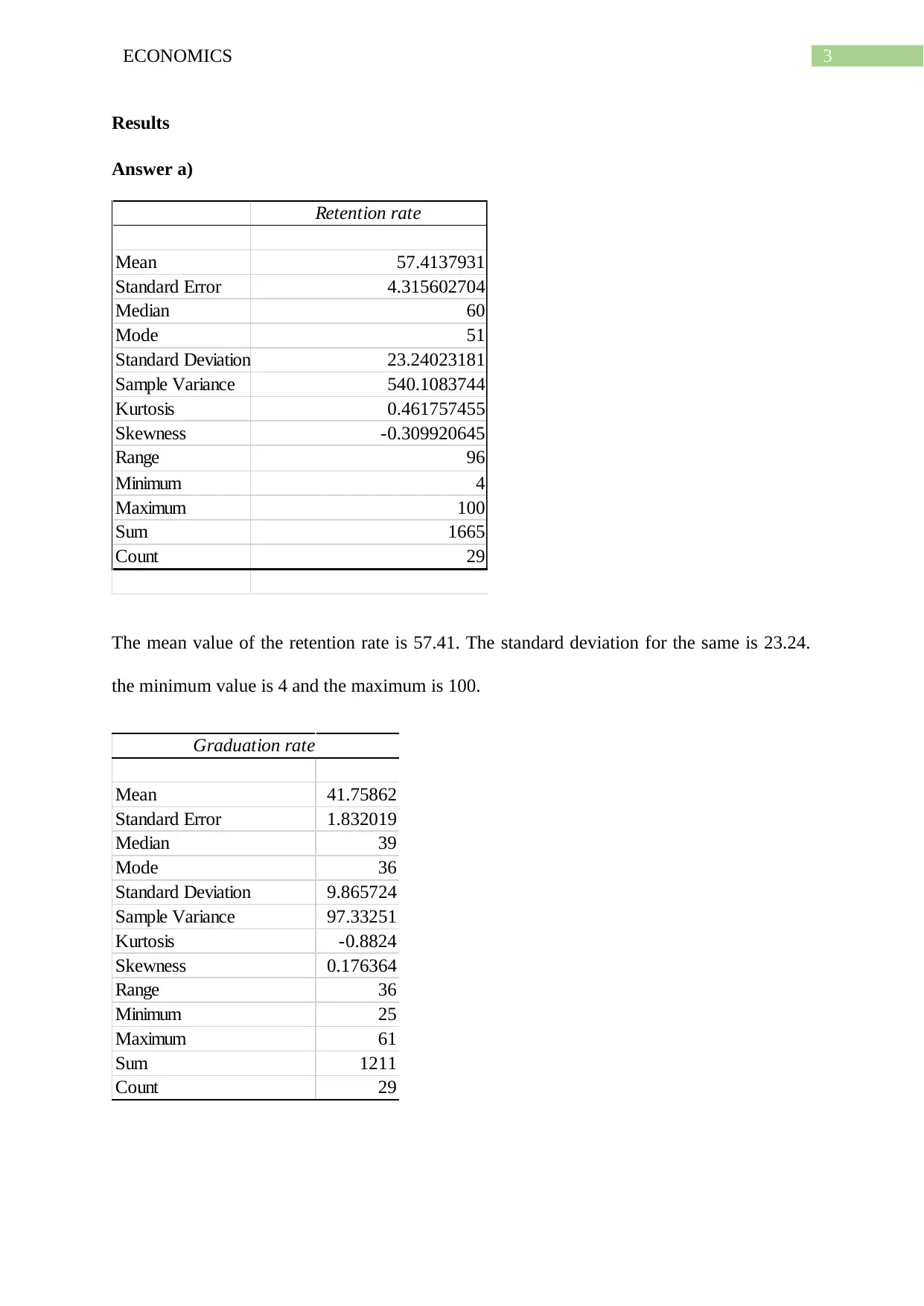
3ECONOMICS
Results
Answer a)
Retention rate
Mean 57.4137931
Standard Error 4.315602704
Median 60
Mode 51
Standard Deviation 23.24023181
Sample Variance 540.1083744
Kurtosis 0.461757455
Skewness -0.309920645
Range 96
Minimum 4
Maximum 100
Sum 1665
Count 29
The mean value of the retention rate is 57.41. The standard deviation for the same is 23.24.
the minimum value is 4 and the maximum is 100.
Graduation rate
Mean 41.75862
Standard Error 1.832019
Median 39
Mode 36
Standard Deviation 9.865724
Sample Variance 97.33251
Kurtosis -0.8824
Skewness 0.176364
Range 36
Minimum 25
Maximum 61
Sum 1211
Count 29
Results
Answer a)
Retention rate
Mean 57.4137931
Standard Error 4.315602704
Median 60
Mode 51
Standard Deviation 23.24023181
Sample Variance 540.1083744
Kurtosis 0.461757455
Skewness -0.309920645
Range 96
Minimum 4
Maximum 100
Sum 1665
Count 29
The mean value of the retention rate is 57.41. The standard deviation for the same is 23.24.
the minimum value is 4 and the maximum is 100.
Graduation rate
Mean 41.75862
Standard Error 1.832019
Median 39
Mode 36
Standard Deviation 9.865724
Sample Variance 97.33251
Kurtosis -0.8824
Skewness 0.176364
Range 36
Minimum 25
Maximum 61
Sum 1211
Count 29
Paraphrase This Document
Need a fresh take? Get an instant paraphrase of this document with our AI Paraphraser
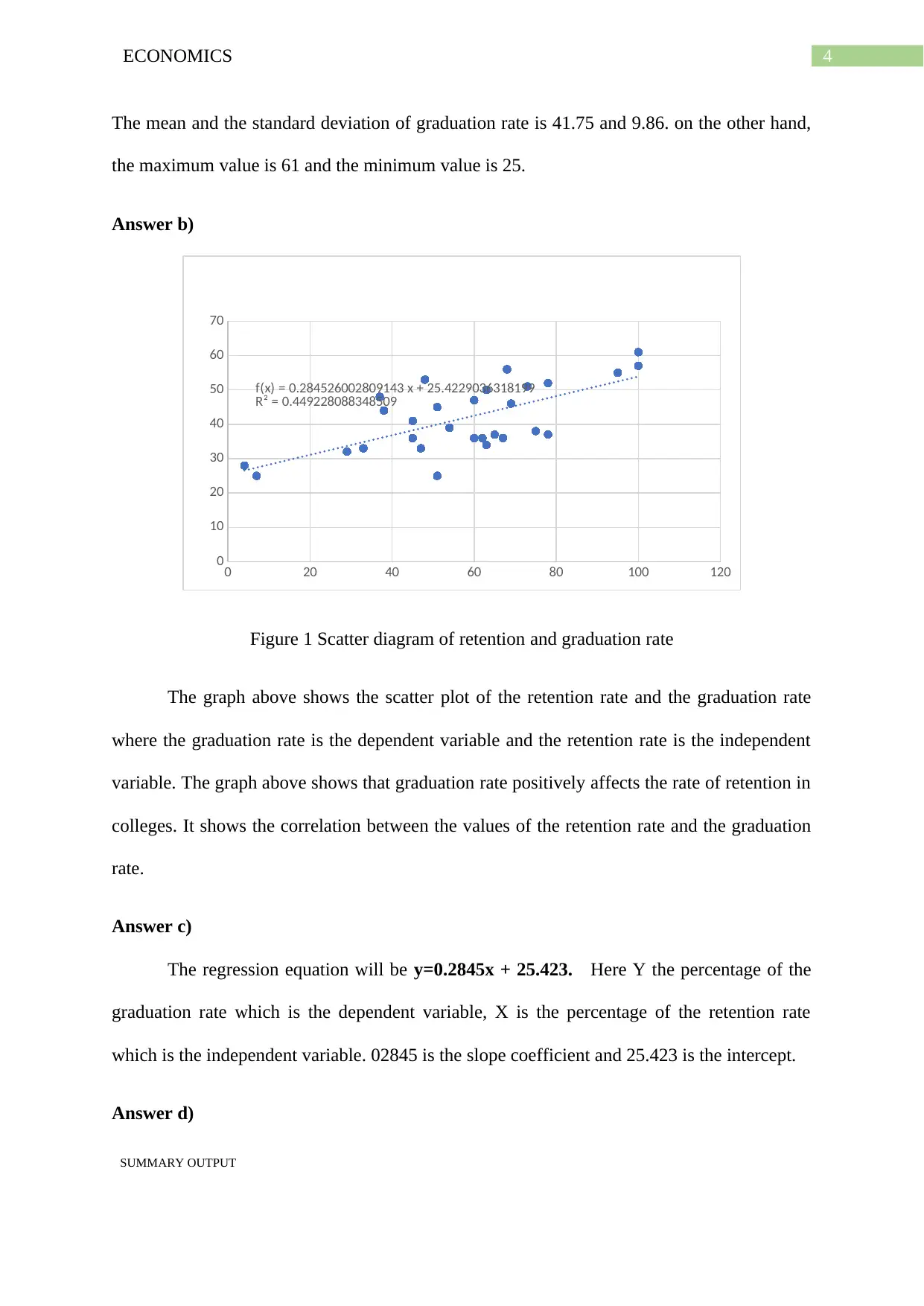
4ECONOMICS
The mean and the standard deviation of graduation rate is 41.75 and 9.86. on the other hand,
the maximum value is 61 and the minimum value is 25.
Answer b)
0 20 40 60 80 100 120
0
10
20
30
40
50
60
70
f(x) = 0.284526002809143 x + 25.4229036318199
R² = 0.449228088348509
Figure 1 Scatter diagram of retention and graduation rate
The graph above shows the scatter plot of the retention rate and the graduation rate
where the graduation rate is the dependent variable and the retention rate is the independent
variable. The graph above shows that graduation rate positively affects the rate of retention in
colleges. It shows the correlation between the values of the retention rate and the graduation
rate.
Answer c)
The regression equation will be y=0.2845x + 25.423. Here Y the percentage of the
graduation rate which is the dependent variable, X is the percentage of the retention rate
which is the independent variable. 02845 is the slope coefficient and 25.423 is the intercept.
Answer d)
SUMMARY OUTPUT
The mean and the standard deviation of graduation rate is 41.75 and 9.86. on the other hand,
the maximum value is 61 and the minimum value is 25.
Answer b)
0 20 40 60 80 100 120
0
10
20
30
40
50
60
70
f(x) = 0.284526002809143 x + 25.4229036318199
R² = 0.449228088348509
Figure 1 Scatter diagram of retention and graduation rate
The graph above shows the scatter plot of the retention rate and the graduation rate
where the graduation rate is the dependent variable and the retention rate is the independent
variable. The graph above shows that graduation rate positively affects the rate of retention in
colleges. It shows the correlation between the values of the retention rate and the graduation
rate.
Answer c)
The regression equation will be y=0.2845x + 25.423. Here Y the percentage of the
graduation rate which is the dependent variable, X is the percentage of the retention rate
which is the independent variable. 02845 is the slope coefficient and 25.423 is the intercept.
Answer d)
SUMMARY OUTPUT
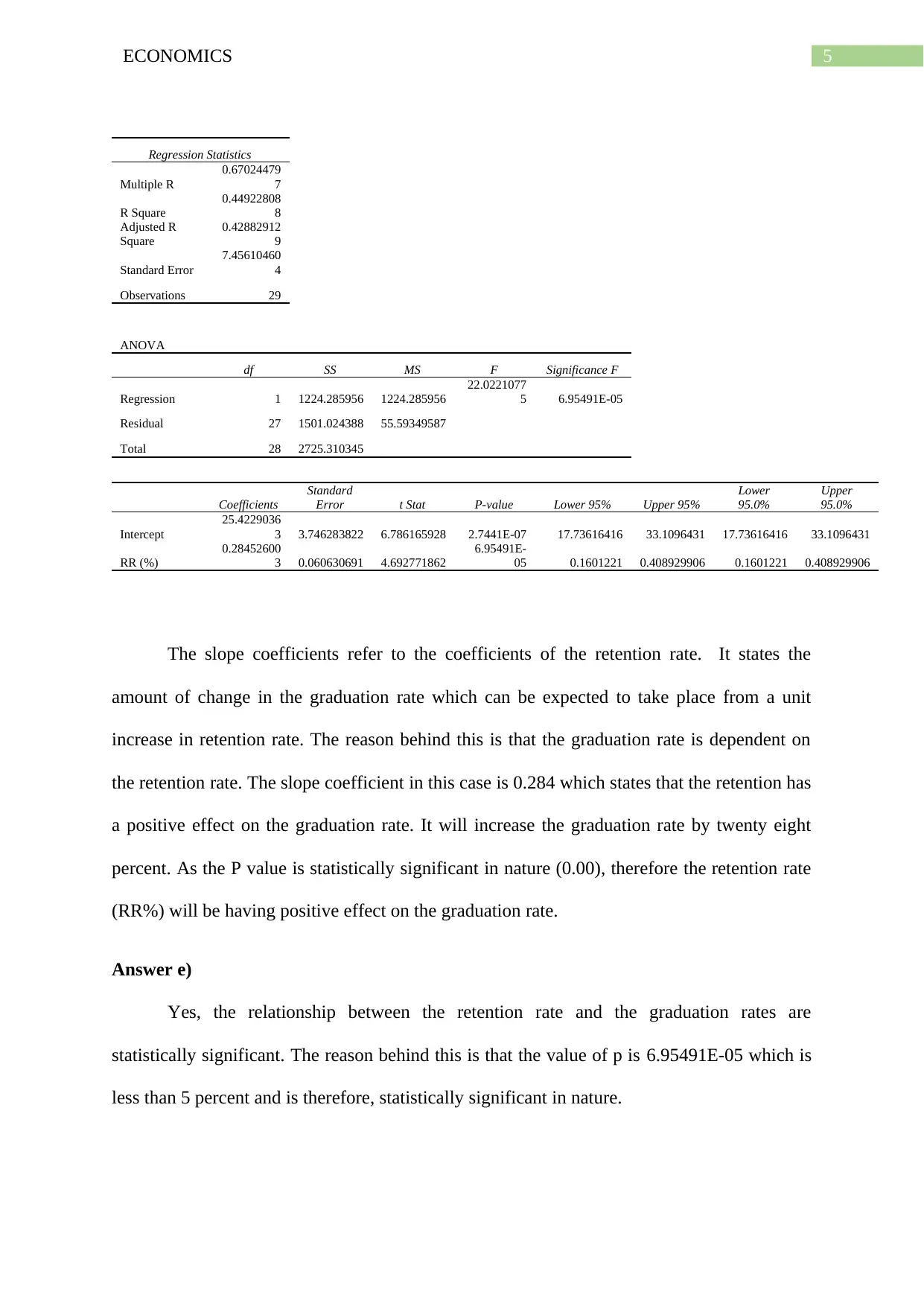
5ECONOMICS
Regression Statistics
Multiple R
0.67024479
7
R Square
0.44922808
8
Adjusted R
Square
0.42882912
9
Standard Error
7.45610460
4
Observations 29
ANOVA
df SS MS F Significance F
Regression 1 1224.285956 1224.285956
22.0221077
5 6.95491E-05
Residual 27 1501.024388 55.59349587
Total 28 2725.310345
Coefficients
Standard
Error t Stat P-value Lower 95% Upper 95%
Lower
95.0%
Upper
95.0%
Intercept
25.4229036
3 3.746283822 6.786165928 2.7441E-07 17.73616416 33.1096431 17.73616416 33.1096431
RR (%)
0.28452600
3 0.060630691 4.692771862
6.95491E-
05 0.1601221 0.408929906 0.1601221 0.408929906
The slope coefficients refer to the coefficients of the retention rate. It states the
amount of change in the graduation rate which can be expected to take place from a unit
increase in retention rate. The reason behind this is that the graduation rate is dependent on
the retention rate. The slope coefficient in this case is 0.284 which states that the retention has
a positive effect on the graduation rate. It will increase the graduation rate by twenty eight
percent. As the P value is statistically significant in nature (0.00), therefore the retention rate
(RR%) will be having positive effect on the graduation rate.
Answer e)
Yes, the relationship between the retention rate and the graduation rates are
statistically significant. The reason behind this is that the value of p is 6.95491E-05 which is
less than 5 percent and is therefore, statistically significant in nature.
Regression Statistics
Multiple R
0.67024479
7
R Square
0.44922808
8
Adjusted R
Square
0.42882912
9
Standard Error
7.45610460
4
Observations 29
ANOVA
df SS MS F Significance F
Regression 1 1224.285956 1224.285956
22.0221077
5 6.95491E-05
Residual 27 1501.024388 55.59349587
Total 28 2725.310345
Coefficients
Standard
Error t Stat P-value Lower 95% Upper 95%
Lower
95.0%
Upper
95.0%
Intercept
25.4229036
3 3.746283822 6.786165928 2.7441E-07 17.73616416 33.1096431 17.73616416 33.1096431
RR (%)
0.28452600
3 0.060630691 4.692771862
6.95491E-
05 0.1601221 0.408929906 0.1601221 0.408929906
The slope coefficients refer to the coefficients of the retention rate. It states the
amount of change in the graduation rate which can be expected to take place from a unit
increase in retention rate. The reason behind this is that the graduation rate is dependent on
the retention rate. The slope coefficient in this case is 0.284 which states that the retention has
a positive effect on the graduation rate. It will increase the graduation rate by twenty eight
percent. As the P value is statistically significant in nature (0.00), therefore the retention rate
(RR%) will be having positive effect on the graduation rate.
Answer e)
Yes, the relationship between the retention rate and the graduation rates are
statistically significant. The reason behind this is that the value of p is 6.95491E-05 which is
less than 5 percent and is therefore, statistically significant in nature.
⊘ This is a preview!⊘
Do you want full access?
Subscribe today to unlock all pages.

Trusted by 1+ million students worldwide

6ECONOMICS
Answer f)
The value of the R squared is used to measure the good of fit in any linear regression
models. Since the value of the R squared in this model is 0.45, the regression equation
provides a moderate fit. The value of the R square indicates that the model could explain only
45 percent of the variance.
Answer g)
If I were the president of South University, I will not have too much concern about
the performance of my university since the percentage of retention rate is quite high
compared to the percentage of graduation rate. When compared to the other online
universities, the retention rate is not hundred percent. Therefore, I should take further steps in
improving the retention of my students.
Answer h)
Being the president of University of Phoenix, it will be a great concern since the
retention rate is only four percent compared to the graduation rate which is 28 percent. The
percentage of the retention rate of the University of Phoenix is the least compared to the other
universities. Therefore, I need to work hard to make sure that the retention rate is increased
and should also look in to matter of the reason behind the low retention rates of students.
Discussions
The following data shows that here the graduation rate is the dependent variable and
the retention rate is the independent variable. The following data set shows the values of the
29 universities retention rate percentages and the graduation rate percentages. The values of
the R squared is found to be 45 percent which states that model states only forty five percent
of the variance. the F test is also significant since its value is zero. The retention rate has a
positive effect on the graduation rate since the coefficient is positive in nature and the p value
Answer f)
The value of the R squared is used to measure the good of fit in any linear regression
models. Since the value of the R squared in this model is 0.45, the regression equation
provides a moderate fit. The value of the R square indicates that the model could explain only
45 percent of the variance.
Answer g)
If I were the president of South University, I will not have too much concern about
the performance of my university since the percentage of retention rate is quite high
compared to the percentage of graduation rate. When compared to the other online
universities, the retention rate is not hundred percent. Therefore, I should take further steps in
improving the retention of my students.
Answer h)
Being the president of University of Phoenix, it will be a great concern since the
retention rate is only four percent compared to the graduation rate which is 28 percent. The
percentage of the retention rate of the University of Phoenix is the least compared to the other
universities. Therefore, I need to work hard to make sure that the retention rate is increased
and should also look in to matter of the reason behind the low retention rates of students.
Discussions
The following data shows that here the graduation rate is the dependent variable and
the retention rate is the independent variable. The following data set shows the values of the
29 universities retention rate percentages and the graduation rate percentages. The values of
the R squared is found to be 45 percent which states that model states only forty five percent
of the variance. the F test is also significant since its value is zero. The retention rate has a
positive effect on the graduation rate since the coefficient is positive in nature and the p value
Paraphrase This Document
Need a fresh take? Get an instant paraphrase of this document with our AI Paraphraser
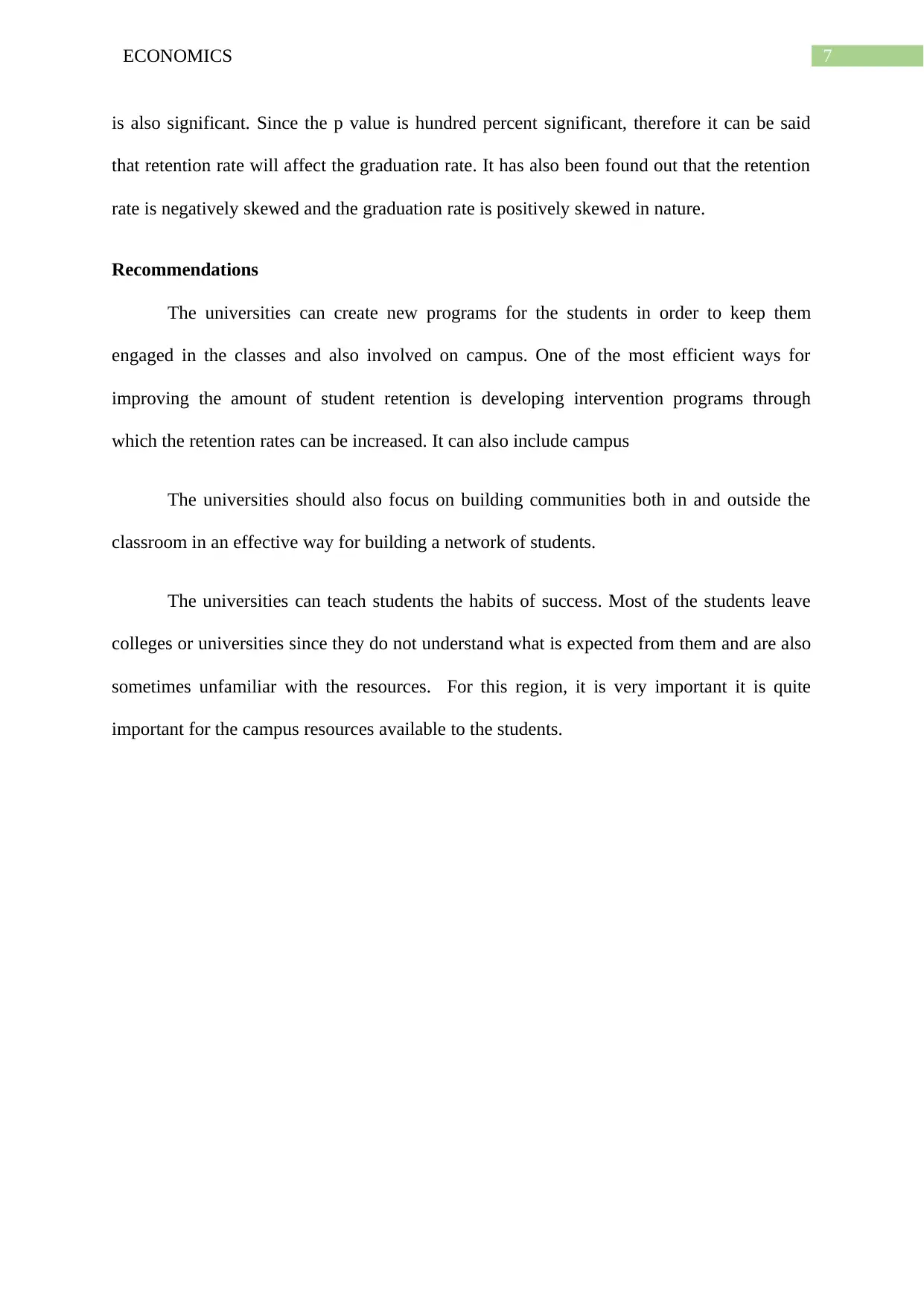
7ECONOMICS
is also significant. Since the p value is hundred percent significant, therefore it can be said
that retention rate will affect the graduation rate. It has also been found out that the retention
rate is negatively skewed and the graduation rate is positively skewed in nature.
Recommendations
The universities can create new programs for the students in order to keep them
engaged in the classes and also involved on campus. One of the most efficient ways for
improving the amount of student retention is developing intervention programs through
which the retention rates can be increased. It can also include campus
The universities should also focus on building communities both in and outside the
classroom in an effective way for building a network of students.
The universities can teach students the habits of success. Most of the students leave
colleges or universities since they do not understand what is expected from them and are also
sometimes unfamiliar with the resources. For this region, it is very important it is quite
important for the campus resources available to the students.
is also significant. Since the p value is hundred percent significant, therefore it can be said
that retention rate will affect the graduation rate. It has also been found out that the retention
rate is negatively skewed and the graduation rate is positively skewed in nature.
Recommendations
The universities can create new programs for the students in order to keep them
engaged in the classes and also involved on campus. One of the most efficient ways for
improving the amount of student retention is developing intervention programs through
which the retention rates can be increased. It can also include campus
The universities should also focus on building communities both in and outside the
classroom in an effective way for building a network of students.
The universities can teach students the habits of success. Most of the students leave
colleges or universities since they do not understand what is expected from them and are also
sometimes unfamiliar with the resources. For this region, it is very important it is quite
important for the campus resources available to the students.
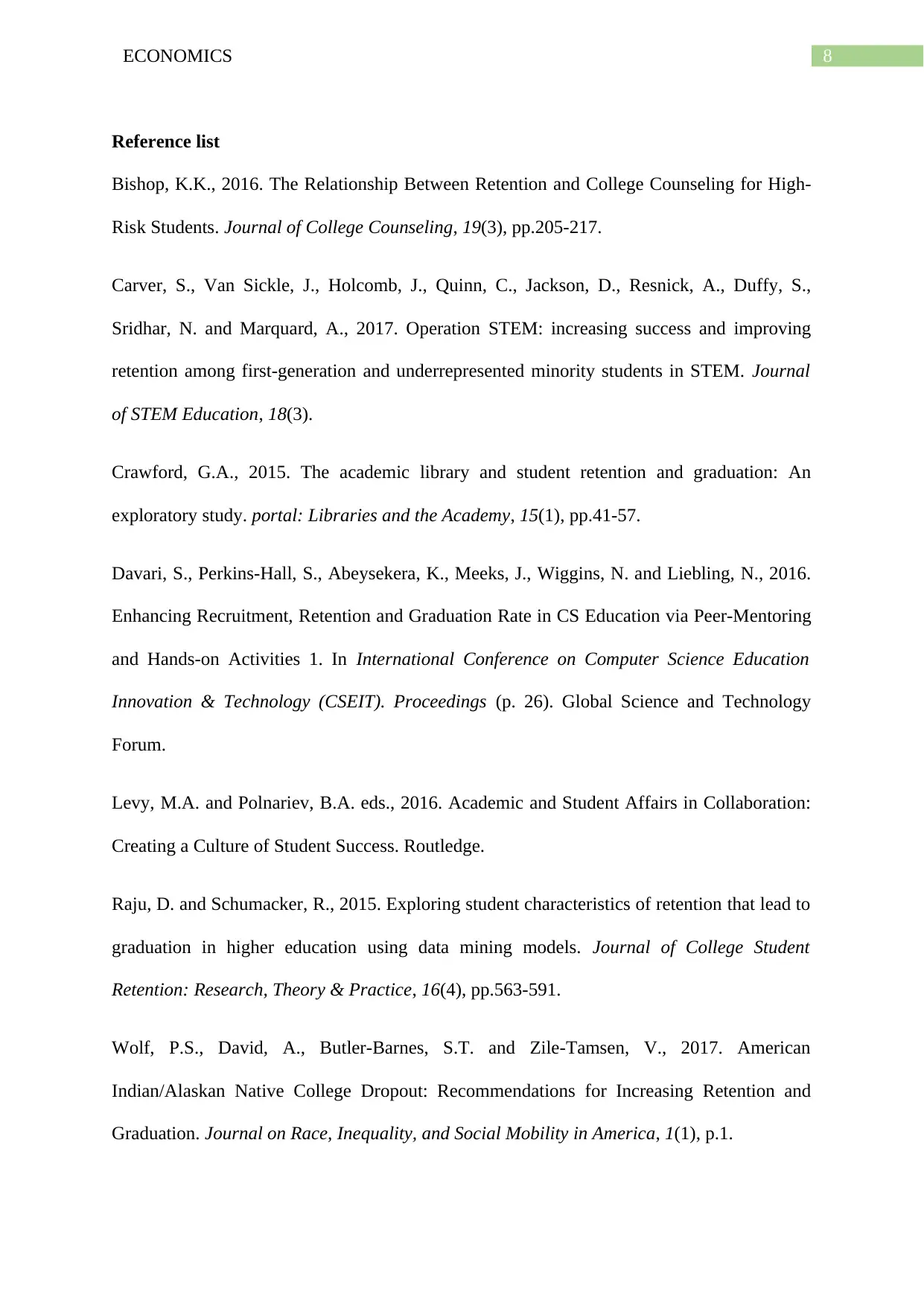
8ECONOMICS
Reference list
Bishop, K.K., 2016. The Relationship Between Retention and College Counseling for High‐
Risk Students. Journal of College Counseling, 19(3), pp.205-217.
Carver, S., Van Sickle, J., Holcomb, J., Quinn, C., Jackson, D., Resnick, A., Duffy, S.,
Sridhar, N. and Marquard, A., 2017. Operation STEM: increasing success and improving
retention among first-generation and underrepresented minority students in STEM. Journal
of STEM Education, 18(3).
Crawford, G.A., 2015. The academic library and student retention and graduation: An
exploratory study. portal: Libraries and the Academy, 15(1), pp.41-57.
Davari, S., Perkins-Hall, S., Abeysekera, K., Meeks, J., Wiggins, N. and Liebling, N., 2016.
Enhancing Recruitment, Retention and Graduation Rate in CS Education via Peer-Mentoring
and Hands-on Activities 1. In International Conference on Computer Science Education
Innovation & Technology (CSEIT). Proceedings (p. 26). Global Science and Technology
Forum.
Levy, M.A. and Polnariev, B.A. eds., 2016. Academic and Student Affairs in Collaboration:
Creating a Culture of Student Success. Routledge.
Raju, D. and Schumacker, R., 2015. Exploring student characteristics of retention that lead to
graduation in higher education using data mining models. Journal of College Student
Retention: Research, Theory & Practice, 16(4), pp.563-591.
Wolf, P.S., David, A., Butler-Barnes, S.T. and Zile-Tamsen, V., 2017. American
Indian/Alaskan Native College Dropout: Recommendations for Increasing Retention and
Graduation. Journal on Race, Inequality, and Social Mobility in America, 1(1), p.1.
Reference list
Bishop, K.K., 2016. The Relationship Between Retention and College Counseling for High‐
Risk Students. Journal of College Counseling, 19(3), pp.205-217.
Carver, S., Van Sickle, J., Holcomb, J., Quinn, C., Jackson, D., Resnick, A., Duffy, S.,
Sridhar, N. and Marquard, A., 2017. Operation STEM: increasing success and improving
retention among first-generation and underrepresented minority students in STEM. Journal
of STEM Education, 18(3).
Crawford, G.A., 2015. The academic library and student retention and graduation: An
exploratory study. portal: Libraries and the Academy, 15(1), pp.41-57.
Davari, S., Perkins-Hall, S., Abeysekera, K., Meeks, J., Wiggins, N. and Liebling, N., 2016.
Enhancing Recruitment, Retention and Graduation Rate in CS Education via Peer-Mentoring
and Hands-on Activities 1. In International Conference on Computer Science Education
Innovation & Technology (CSEIT). Proceedings (p. 26). Global Science and Technology
Forum.
Levy, M.A. and Polnariev, B.A. eds., 2016. Academic and Student Affairs in Collaboration:
Creating a Culture of Student Success. Routledge.
Raju, D. and Schumacker, R., 2015. Exploring student characteristics of retention that lead to
graduation in higher education using data mining models. Journal of College Student
Retention: Research, Theory & Practice, 16(4), pp.563-591.
Wolf, P.S., David, A., Butler-Barnes, S.T. and Zile-Tamsen, V., 2017. American
Indian/Alaskan Native College Dropout: Recommendations for Increasing Retention and
Graduation. Journal on Race, Inequality, and Social Mobility in America, 1(1), p.1.
⊘ This is a preview!⊘
Do you want full access?
Subscribe today to unlock all pages.

Trusted by 1+ million students worldwide

9ECONOMICS
1 out of 10
Related Documents
Your All-in-One AI-Powered Toolkit for Academic Success.
+13062052269
info@desklib.com
Available 24*7 on WhatsApp / Email
![[object Object]](/_next/static/media/star-bottom.7253800d.svg)
Unlock your academic potential
Copyright © 2020–2026 A2Z Services. All Rights Reserved. Developed and managed by ZUCOL.





